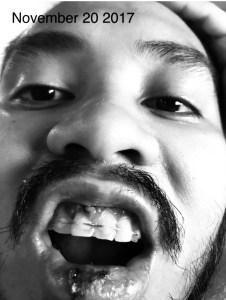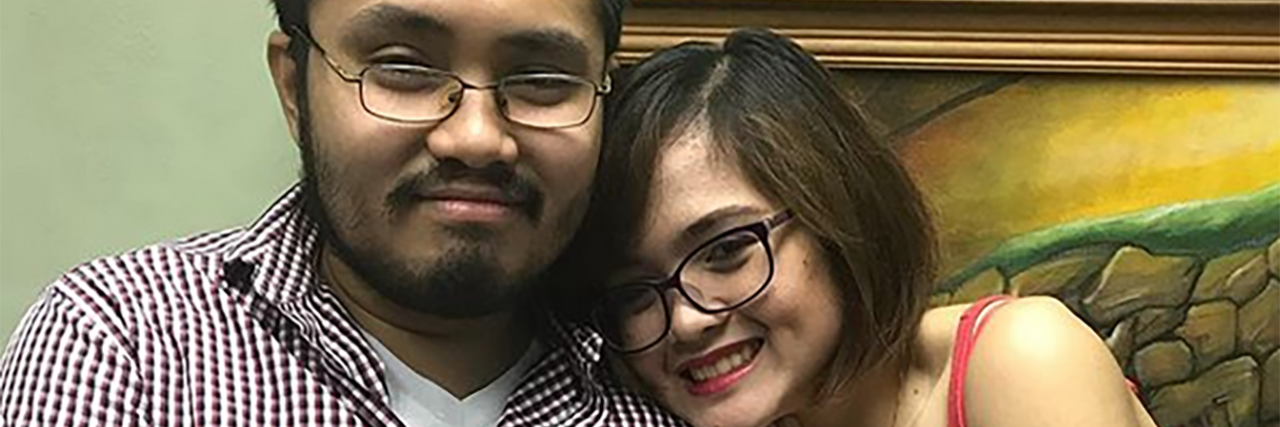Recently my partner Jared got into an accident. We were supposedly on a week-long vacation from work, thanks to the ASEAN summit. The incident happened at the swimming pool of a hotel and resort we visited in Tanza, Cavite.
It was only our second day there, out of the three days we planned on chilling, and just having fun. And have fun we did — at the swimming pool, which happened to have three slides. My cousins and I had tried these slides a few times in the past, and we always reached the other end just fine. That day there were young children and teenagers playing in the slides, so it looked especially safe.
But midway through Jared’s slide down, he took a bad turn. He began sliding on his belly, feet-first. His teeth grazed concrete, and he emerged at the end with a bleeding lip.
There was a lot of panic. The moment he screamed out to me that he was bleeding, alarm bells went off in my head. I knew it could not be good — considering he has hemophilia.
A person with hemophilia would always have the chance of bleeding to death in the “perfect” conditions (and I use the word “perfect” ironically). That moment, I knew we might have come so close to being in the perfect situation. Something had to be done right away.
I have to admit I was scared at first. I knew Jared had been in and out of hospital several times in his childhood, but during our three (going on four) years together thus far, he had never been hospitalized. This would be his first hospital stay in a very long time — and to think I was his only companion going there (apart from the hotel staff who were kind enough to bring us to the ER).
In this post, I will explain what happened in as much detail as I can remember (in the flurry of events from the accident to his sudden confinement). But before you proceed, I request you, dear reader, to suspend judgment.
You could say it was a foolish decision for him to go on the slide in the first place. Sure it was, but saying so wouldn’t be very considerate of him as a human being.
Warning: People With Disabilities Are Human, Too
Disability is more than a stick-figure guy in a wheelchair. If there’s one thing I’ve learned from interacting with other people with disabilities, learning about what makes them tick, about their dreams and desires in life — it’s that people with disabilities are human beings before anything else. They simply happen to have disabilities, and as a result their needs may be different from “normal” folks’. But that doesn’t make them any less human.
Just like other human beings, people with disabilities have dreams! And most of the people with disabilities I’ve met share one very simple desire — to live normally, to be able to do the same things so-called “normal” people can do — to enjoy, to have fun, to make the most of life. And so this desire can lead people with disabilities to try pushing their limits — to see if they can still be safe doing certain things despite discouragement from others (even medical “experts”).
Imagine being told all your life that you can’t do certain “fun” things because they’re unsafe. It’s not easy to understand that as a child. When you’re young, you want to belong, and being banned from doing enjoyable things with your peers goes against that. As a result, you feel isolated, when all you really want is acceptance. This feeling can last for a long time, even until you’re an adult. It’s not easy to accept the fact that you’re different. There will always be a voice inside your head telling you that you need to prove your worth (even if it’s not worth the trouble), otherwise other people won’t accept you.
Granted, both Jared and I managed to learn a lesson from the incident that will surely stick with us for the rest of our lives. Safety always comes first — and from now on (at least for the two of us), no more pool slides.
Tuesday (Nov. 14): The Day of the Accident and Overnight Hospital Stay
When we arrived at the hospital, Jared’s lower lip was open and bleeding in two places (above and below). We thought he had lost a tooth, but in reality his front incisor got pushed back into the gum and skull (intrusion).
As per doctor’s evaluation, Jared was admitted in the hospital for one night to receive surgery. He needed to get lip stitches to close the wound and stop the bleeding. Since his co-morbid condition (hemophilia) was critical, he had to be observed by an anesthesiologist, an oral surgeon, and an internist.
Thankfully, he had managed to get a Factor 9 infusion (good for 48 hours) before we left for Tanza. This led to the following good consequences:
1. The surgery (suturing) pushed through without complications.
2. He didn’t lose too much blood — there was bleeding, but it was easily controlled.
The dentist then gave us two options for fixing his tooth. The conservative option: to pull his tooth back down and wait for it to embed into the skull again. However, his panoramic x-ray showed that the root of the tooth might already be damaged. This meant the tooth would eventually decay, and a root canal would be needed. On the other hand, we could just have the tooth pulled out altogether and replaced with a denture.
Neither procedure could be done on the spot, though, as the dentist insisted on getting clearance from a hematologist — one such “complication” of his hemophilia.
We decided to hold our decision until we were back in Manila so we could get advice from other medical professionals. Besides, it would be so much easier to postpone the complicated procedure to a time when factor would be easily obtainable. Jared is very much blessed to have doctors in the family — both his father and his older brother are a dermatologist and ENT-in-training, respectively.
Thursday (Nov. 20): Toothless No More; Pseudo-Retainers
On Wednesday evening we went back to metro Manila. It was around 8 p.m. when we arrived.
We skipped three days of work after that: Thursday, Friday, and Monday. What we missed out due to Jared’s sudden hospitalization, we made up in days spent chilling at home. We managed to catch up on (and finish!) two TV series: “Transparent” and the latest “Riverdale” episodes we hadn’t seen yet.
 We spent almost all of Thursday seeing doctors and researching ways for his damaged tooth to stop being a problem. A trip to his regular dentists ultimately put a cap on our search when they suggested to pull down the intruded tooth and splint it against the surrounding teeth. The splint was just a thin wire bonded to his tooth, which looked a lot like my retainers! It would have to stay on for a few months. At the same time, we would have to observe if the tooth would change color — as this would signal a need for a root canal.
We spent almost all of Thursday seeing doctors and researching ways for his damaged tooth to stop being a problem. A trip to his regular dentists ultimately put a cap on our search when they suggested to pull down the intruded tooth and splint it against the surrounding teeth. The splint was just a thin wire bonded to his tooth, which looked a lot like my retainers! It would have to stay on for a few months. At the same time, we would have to observe if the tooth would change color — as this would signal a need for a root canal.
The dental procedure turned out to be quick and easy, and virtually pain-free. Since these were Jared’s regular dentists, they knew about his condition, and were aware that Factor 9 would be available. As a result, there was no hesitance on their part to perform the procedure.
We’re now in the process of recovery. It may take a few months before the splint can be taken out and his tooth (hopefully) returns to its normal state. Jared’s still on a soft diet. I still have flashbacks of the incident that make me shudder, but our focus has always been to move forward.
Regardless of what challenges may come our way, it is but wise to keep moving forward.
#HemoGirlfriend Says
One of my major qualms about the present thrust of the conversation regarding people with disabilities is the lack of visibility of loved ones, especially partners.
When people talk about the well-being of people with disabilities, only two people are normally involved in the conversation: 1) the person with a disability himself or herself, and 2) the parent and/or immediate family members. But people with disabilities can and do fall in love, and their partners also tend to take a considerable, if not equal, share in caring for them and making sure their needs are met.
When something stressful happens to the person with a disability, the “normal” partner also gets stressed. He or she also bears the brunt of the incident. He or she must attend to the necessary paperwork, worry about fees and insurance, and keep watch on the other’s bedside — all while having to keep a level head (because historically speaking, nothing good ever comes from panicking).
It’s surprising how easy it gets to be in the end, when you know it’s all over and both of you can rest assured all is well — when you love someone and can’t bear to lose them in the first place.
Just as the person with a disability needs care, so do his or her “carers.” A little support can go a long way. Partners of people with disabilities need to have a strong support system as well, so they can continue to give quality support to their loved one whenever he or she might need it.
A hospital would probably be the last place someone would have in mind if they wanted to go on a date. Most couples our age might be going to malls, hiking up mountains, or snapping Instagram-worthy photos at picturesque beaches. They might spend their vacations in bars with their friends, getting drunk ’til midnight. Maybe that works for them — good for them, then. But for us, things work a bit differently — and that’s OK.
On good days, we still get to do the things regular couples do. We eat out, drive to the mall, and head to the office every day. It’s also added perk that we work at the same office, and our superiors are fine with the arrangement. We’re life partners to one another.
But when a bad day strikes, sometimes the routine gets interrupted. Sometimes emotions go on strike as well.
Nonetheless, it’s fine. It works for us — it works for me, too. I’m contented to know I’m loved, and that alone makes me happy. And doing things for another person — the process of attempting to understand a condition I will never fully get — is something I find truly meaningful.
That’s got to be a valid choice in this world.
Follow this journey on Or Simply Cza.
We want to hear your story. Become a Mighty contributor here.
Photos by contributor.

